中职英语拓展模块教案第六周
- 格式:doc
- 大小:59.50 KB
- 文档页数:10
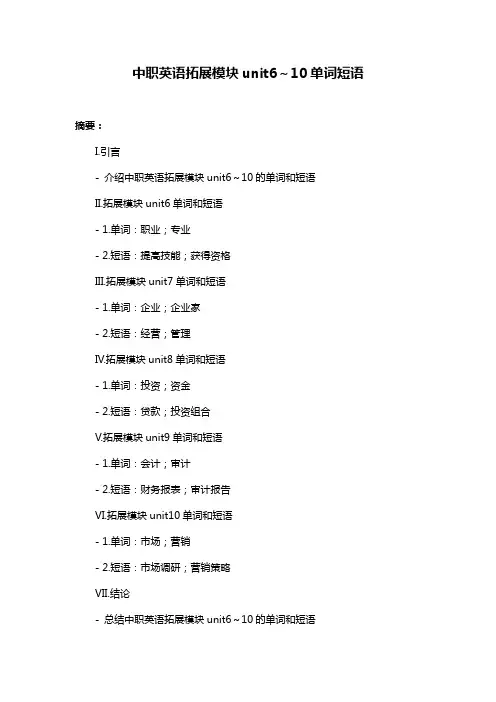
中职英语拓展模块unit6~10单词短语摘要:I.引言- 介绍中职英语拓展模块unit6~10的单词和短语II.拓展模块unit6单词和短语- 1.单词:职业;专业- 2.短语:提高技能;获得资格III.拓展模块unit7单词和短语- 1.单词:企业;企业家- 2.短语:经营;管理IV.拓展模块unit8单词和短语- 1.单词:投资;资金- 2.短语:贷款;投资组合V.拓展模块unit9单词和短语- 1.单词:会计;审计- 2.短语:财务报表;审计报告VI.拓展模块unit10单词和短语- 1.单词:市场;营销- 2.短语:市场调研;营销策略VII.结论- 总结中职英语拓展模块unit6~10的单词和短语正文:中职英语拓展模块unit6~10的单词和短语是非常实用的,涉及到很多职业和企业方面的内容。
在unit6中,我们学习了职业(job)和专业(major)两个单词,以及提高技能(improve skills)和获得资格(get qualifications)两个短语。
这些内容可以帮助我们更好地了解自己的职业规划和发展方向。
在unit7中,我们学习了企业(company)和企业家(entrepreneur)两个单词,以及经营(run)和管理(manage)两个短语。
这些内容可以帮助我们了解企业的运作和管理,为将来的创业和管理做好准备。
在unit8中,我们学习了投资(investment)和资金(fund)两个单词,以及贷款(loan)和投资组合(portfolio)两个短语。
这些内容可以帮助我们了解投资的基本概念和技巧,为将来的投资决策做好准备。
在unit9中,我们学习了会计(accounting)和审计(audit)两个单词,以及财务报表(financial statement)和审计报告(audit report)两个短语。
这些内容可以帮助我们了解会计和审计的基本知识和技能,为将来的财务管理和审计做好准备。
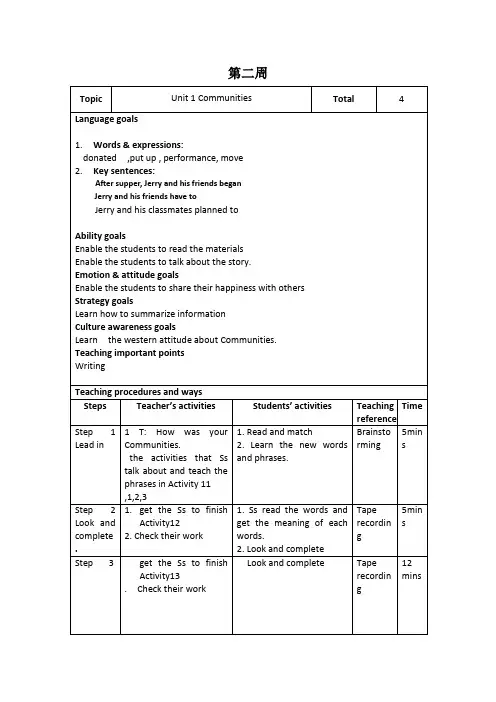
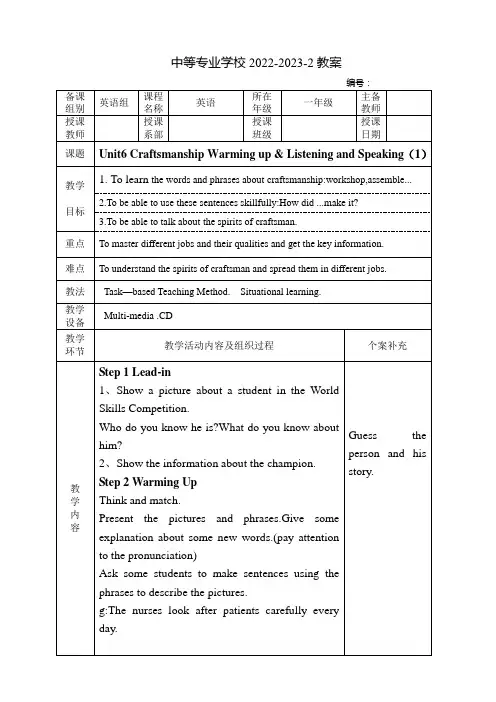
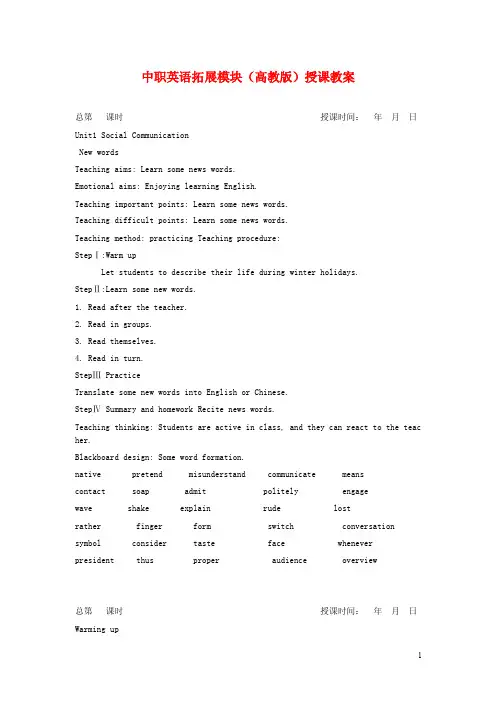
中职英语拓展模块(高教版)授课教案总第课时授课时间:年月日Unit1 Social CommunicationNew wordsTeaching aims: Learn some news words.Emotional aims: Enjoying learning English.Teaching important points: Learn some news words.Teaching difficult points: Learn some news words.Teaching method: practicing Teaching procedure:StepⅠ:Warm upLet students to describe their life during winter holidays.StepⅡ:Learn some new words.1. Read after the teacher.2. Read in groups.3. Read themselves.4. Read in turn.StepⅢ PracticeTranslate some new words into English or Chinese.StepⅣ Summary and homework Recite news words.Teaching thinking: Students are active in class, and they can react to the teac her.Blackboard design: Some word formation.native pretend misunderstand communicate meanscontact soap admit politely engagewave shake explain rude lostrather finger form switch conversation symbol consider taste face whenever president thus proper audience overview总第课时授课时间:年月日Warming upTeaching aims: Learn some news words.Emotional aims: Learn some manners in language communication.Teaching important points: Discuss some questions.Teaching difficult points: Learn some news words.Teaching method: practicing and discussing.Teaching procedure: StepⅠRevisionReview some words.StepⅡ Discussion 讨论课文插图Now look at the picture in the reading text "Etiquette in Language Communic ation".What can you see in it?-From the picture, we can see a woman is talking with a man. But the manlooks a bit uneasy, maybe he is nervous. Obviously it's not a smooth language c ommunication.StepⅢ提示相关生词和短语,如:native speaker, native language, have trouble in doing sth, pretend to do sth, repeat, explain, manner等。
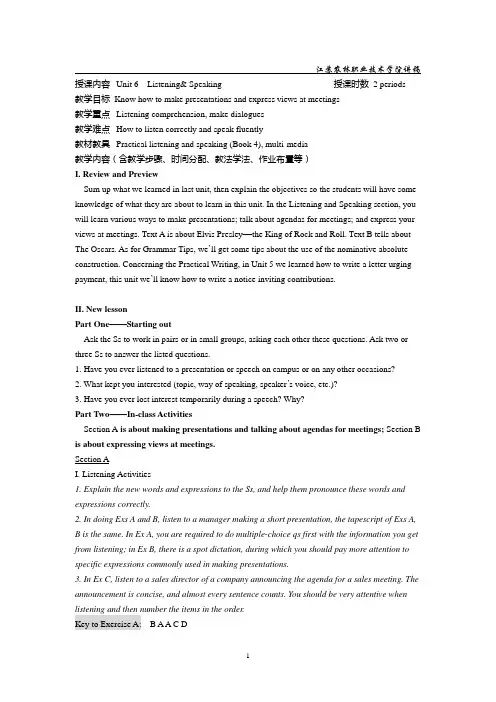
授课内容Unit 6 Listening& Speaking 授课时数2 periods教学目标Know how to make presentations and express views at meetings教学重点Listening comprehension, make dialogues教学难点How to listen correctly and speak fluently教材教具Practical listening and speaking (Book 4), multi-media教学内容(含教学步骤、时间分配、教法学法、作业布置等)I. Review and PreviewSum up what we learned in last unit, then explain the objectives so the students will have some knowledge of what they are about to learn in this unit. In the Listening and Speaking section, you will learn various ways to make presentations; talk about agendas for meetings; and express your views at meetings. Text A is about Elvis Presley—the King of Rock and Roll. Text B tells about The Oscars. As for Grammar Tips, we’ll get some tips about the use of the nominative absolute construction. Concerning the Practical Writing, in Unit 5 we learned how to write a letter urging payment, this unit we’ll know how to write a notice inviting contributions.II. New lessonPart One——Starting outAsk the Ss to work in pairs or in small groups, asking each other these questions. Ask two or three Ss to answer the listed questions.1. Have you ever listened to a presentation or speech on campus or on any other occasions?2. What kept you interested (topic, way of speaking, speaker’s voice, etc.)?3. Have you ever lost interest temporarily during a speech? Why?Part Two——In-class ActivitiesSection A is about making presentations and talking about agendas for meetings; Section B is about expressing views at meetings.Section AI. Listening Activities1. Explain the new words and expressions to the Ss, and help them pronounce these words and expressions correctly.2. In doing Exs A and B, listen to a manager making a short presentation, the tapescript of Exs A,B is the same. In Ex A, you are required to do multiple-choice qs first with the information you get from listening; in Ex B, there is a spot dictation, during which you should pay more attention to specific expressions commonly used in making presentations.3. In Ex C, listen to a sales director of a company announcing the agenda for a sales meeting. The announcement is concise, and almost every sentence counts. You should be very attentive when listening and then number the items in the order.Key to Exercise A: B A A C DKey to Exercise B: 1. introduce myself 2. give you some information 3. may I say 4. draw your attention 5. most rapid 6. need to consider 7. very risky 8. In conclusion 9. very little room for expansion 10. have any questionsKey to Exercise C: Order: 2 4 6 5 1 3II. Speaking Activities1. Studying the expressions of Ex A, pay special attention to the words or phrases in bold italics, which are very often set phrases, fixed sentence patterns or business idioms.2. Exs B and C are writing and speaking tasks. The short presentation in Ex B is quite similar to what you heard in the listening exs. You should not find the presentation here difficult to practise. Exercise A: Study the expressions used in making a presentation until you can say them from memory. Pay special attention to the highlighted expressions.Key to Exercise B: (1)introduce myself (2)The aim of my talk (3)First of all (4)draw your attention to (5)My second point (6)Thirdly (7)in conclusion (8)Thank you for your attention (9)I’ll be happySection BI. Listening Activities1. Make sure that the Ss can pronounce the new words or phrases correctly.2. In Exercise A, listen to parts of a meeting during which the participants talk about the items on the agenda, supply the missing information in the minutes of the meeting.3. Exercise B focuses on what expressions to use in order to express your views at a meeting. The expressions will be useful in doing the speaking tasks. Listen again and supply the missing words or phrases.Key to Exercise A: Part A: (2)To work out the costs (3)Carol (4) Next MondayPart B: (5)To keep the sales office telephone lines open (6) To have a trial period (7) Stephen (8) In three monthsKey to Exercise B: Part A: (1)the first item (2)go first (3)I agree (4)deal with that(5)How soonPart B: (1) The next item (2) fill us in (3) get through (4) take on (5) the extra costs(6)Why don’t we (7) take care of it (8) review (9) break for lunchII. Speaking Activities1. Studying the expressions of Ex A, read these expressions and try to remember as much as you can, esp. the words or phrases in bold italics.2. Exs B and C are writing and speaking tasks. B is quite similar to what you heard in the listening exs. You should not find the short conversation here difficult to practise.Exercise A: Study the expressions people use at a meeting until you can say them with your textbook closed. Pay special attention to the highlighted expression.Key to Exercise B: (1)the first item (2)Who wants to go first (3)What do you mean(4)How do you feel (5)our market share (6)potential customers (7) What do you think (8)What do you suggestPart Three——After-class ActivitiesSections A is on the theme of the unit. Listen to two short telephone messages about arranging for a business meeting and then do a spot dictation exercise. Sections B, C, D are of almost the same degree of difficulty as the listening section of the Practical English Test for Colleges (Level A). The format is exactly the same.Section AListen to two recorded telephone messages about organizing a conference and then supply the missing words or phrases(2) middy (3)non-meat (4)vegetarians Message 2: (1)expenses (2) hotel accommodation (3)their flights (4)share taxisSection BListen to short dialogues and choose the best answer to the question you hear after each dialogue.DAADB CBDBCSection CListen to short conversations and then choose the best answer to each question you hear.Conversation 1: CB Conversation 2: ACBSection DListen to the short passage and answer the qs by completing the statements given below.Passage 1: 1. they know 2. a house 3. solve such problems 4. lawyers 5. ExperiencePassage 2: 1. arrive in Chicago 2. the situation 3. take a taxi 4. 7:50 5. disappointedIII. Homework1. Review the expressions and sentences we’ve learned, and speak aloud after class;2. Read text A and get the main idea of it.Self-reflection授课内容Unit 6 Text A &Related Exs 授课时数 2 periods教学目标To get the main idea of Text A——Elvis Presley: the king of Rock and Roll教学重点Language points in the text (words, expressions, structures and translation)教学难点Comprehension of the text and some complicated sentences教材教具An Integrated Skills Course(4), chalks and multimedia computer教学内容(含教学步骤、时间分配、教法学法、作业布置等)I. RevisionAsk several students to give a one-minute presentation on one of the following topics:1. My hobby: advice to beginners2. How to buy a computer3. Why you should buy my company’s products/ servicesII. Lead-in1. Warm-up Activities1) Which do you prefer, classical music or popular music? Why?2) What role can art play in society, esp. when society is becoming increasingly rich materially? This section serves as a warm-up to activate students’ existing knowledge and to encourage them to share their personal experiences or opinions on the theme of the unit.①Choose a group member to lead the discussion.②Ask all group members to take notes on what others say.③Ask one or two students to report their discussion to the whole class.2. Background informationWhat is art? Perhaps, everyone knows that art is the creation of beautiful or significant things. Art includes music, dance, sculpture, painting, drawing, weaving, literature, woodworking, etc. It is a medium of expression where the individual and culture come together. Art, in its broadest meaning, is the expression of creativity or imagination. Art also is an assisted reproductive technology. Architecture is the art of planning and designing buildings. Photographs or other visual representations are a printed publication. Art shows an artist’s skill observation, and creative power. Art enriches our daily life.III. Careful Reading of Text A1) Part Division of the TextAsk Ss to read the whole text and then divide it into 3 parts:Part 1 (Paragraphs 1-2): Elvis Presley was the King of Rock and Roll and the greatest performer in America.Part 2 (Paragraphs 3-6): Elvis Presley was the King of Rock and Roll and the greatest performer in America.Part 3 (Paragraphs 7-8): Although not all people liked him, Elvis Presley still ranked 8th among the top 100 Americans.2) Language Points of the Text1. From 1956 to 1959, there was not one week when an Elvis song was not on the charts: Sentence Paraphrase: Every week from 1956 to 1959, there was an Elvis song on the charts. Sentence Translation:从1956年到1959年,没有一周埃尔维斯的歌不出现在每周流行歌曲榜上。

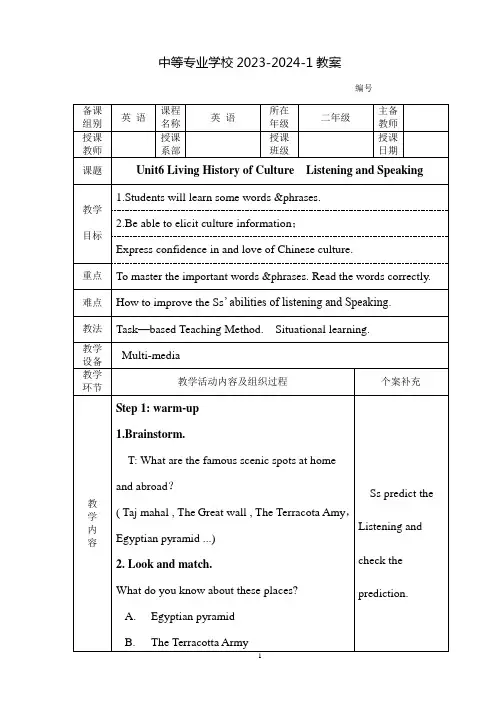
中等专业学校2023-2024-1教案编号中等专业学校2023-2024-1教案中等专业学校2023-2024-1教案中等专业学校2023-2024-1教案教学内容(C)Italians(D)Japanese Step4 conclusionStep 5: Homework板书设计Unit6 Living History of CultureWriting & Culture Understanding(1) The very first destination that I went to visit in Xi’an was Terracotta ArmyThe very first thing that we went to see in India was The Taj Mahal.by...(2)According to the passage,people inoften have aa late breakfast教后札记中等专业学校2023-2024-1教案教学内容(2)Read and group:原因状语从句:since,because,as,for...让步状语从句:even if/though, though,although,while,as...目的状语从句:in order that, so that, in case...(3)Step 3: Presentation1.Read and underline.The teacher explains the basic grammar structureand application rules of attributive clauses.I got up early so that I could get to school on time. 目的状语从句Even though I got up early, I didn’t get to schoolon time.让步状语从句Since I got up early, I got to school on time. 原因状语从句Even if/though Since So that2 1,7 5,8Ss read thesentences andsummarize theusages ofgrammar.Ss learn thebasic forms ofattributive clauses中等专业学校2023-2024-1教案。

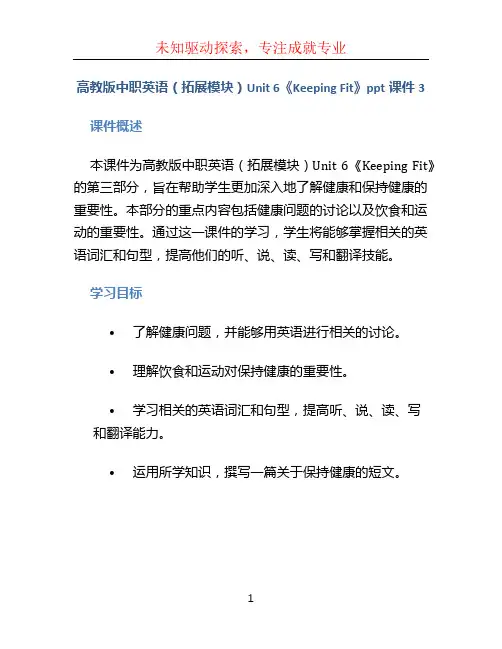
高教版中职英语(拓展模块)Unit 6《Keeping Fit》ppt课件3课件概述本课件为高教版中职英语(拓展模块)Unit 6《Keeping Fit》的第三部分,旨在帮助学生更加深入地了解健康和保持健康的重要性。
本部分的重点内容包括健康问题的讨论以及饮食和运动的重要性。
通过这一课件的学习,学生将能够掌握相关的英语词汇和句型,提高他们的听、说、读、写和翻译技能。
学习目标•了解健康问题,并能够用英语进行相关的讨论。
•理解饮食和运动对保持健康的重要性。
•学习相关的英语词汇和句型,提高听、说、读、写和翻译能力。
•运用所学知识,撰写一篇关于保持健康的短文。
课件内容1. 健康问题讨论在本部分的第一部分,我们将讨论一些常见的健康问题,通过阐述这些问题的原因、影响以及可能的解决方法,进一步加深学生对健康问题的理解。
1.1 健康问题列表下面是一些常见的健康问题。
请大家针对这些问题进行思考,并提出自己的看法。
•肥胖•健康饮食•缺乏运动•压力过大•睡眠不足•眼睛疲劳1.2 健康问题讨论请大家结合自己的日常生活经验,用英语回答以下问题:1.What do you think are the main causes of obesity?2.What are some consequences of not having a healthydiet?3.How does lack of exercise affect our health?4.What are the common symptoms of stress?5.How can we improve our sleep quality?6.What are the main causes of eye fatigue?通过这些问题的讨论,学生将能够了解到这些健康问题的根源和影响,从而更深入地认识到健康的重要性。
2. 饮食与运动在本部分的第二部分,我们将一起探讨饮食与运动对保持健康的重要性。
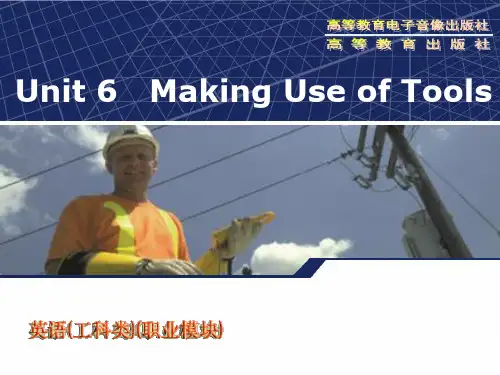

2016年河北省职业院校信息化教学大赛语文出版社中职英语拓展模块Unit6 Chinese HeritageReading: Beijing Opera (Period Two)教学设计2016年8月14日Unit 6 Reading Beijing Opera 教学设计一、教学内容分析本课选自语文出版的中等职业教育课程改革国家规划新教材全国中等职业教育教材审定委员会审定《英语(拓展模块)》Unit 6 National treasures Reading。
是满足中职学生个性发展和继续升学需要选修的公共基础英语教学内容。
主要围绕Beijing Opera这一话题展开的,讲述了京剧的历史、特点、角色、象征、名角名家等,为中职生了解、学习、传扬中国传统文化艺术提供了良好的契机。
新课程标准强调英语教学要从学生的生活经验和认知水平、兴趣出发,倡导体验,实践、参与、合作与交流的学习方式和任务型教学途径,发展学生的综合运用能力。
作为一单元的核心和基础部分,本节教学重点是提高学生阅读能力及如何通过阅读获得知识、运用知识的能力。
因本课文较长,内容较为深奥,在有限的时间内,如何在以阅读为主的教学过程中引导学生学习语言知识并运用这些知识进行语言交际、交流成为本课的难点。
为此教师要在教学中把握重点,突破难点,为下面的Speaking and Speaking和Writing部分提供语言输入,奠定了内容基础和能力基础。
二、教学目标分析根据教学大纲的要求以及授课对象确定教学目标如下:1.知识与技能目标(1). 在学习和掌握30个hot words and 10个useful expressions 的用法基础上,通过阅读从历史、特点、角色等五个方面了解京剧,引导学生理解、感悟京剧艺术。
(2).逐步提高阅读能力和交流沟通能力;培养学生对京剧的欣赏能力。
2. 情感与态度目标(1).通过课堂教学音频、视频欣赏、文本阅读、课堂练习,学生们了解,并喜欢聆听和观看京剧,陶冶情操,增强艺术民族自豪感。
中职英语拓展模块教案第四周教案名称:中职英语拓展模块第四周教案教学目标:1.学习并掌握拓展词汇和短语;2.学习并掌握拓展语法知识;3.培养学生的口语表达能力和交际能力;4.提高学生的阅读和写作能力。
教学重点:1.拓展词汇和短语的学习及应用;2.拓展语法知识的学习及应用。
教学难点:1.拓展词汇和短语的灵活运用;2.拓展语法知识的综合应用。
教学准备:教材、多媒体设备、笔记本电脑、教学课件。
教学过程:Step 1:导入 (5分钟)1.教师与学生互相问候并介绍本周教学主题:拓展模块第四周。
2.分享一段关于拓展词汇和短语的视频,并与学生一起回顾上周的教学内容。
Step 2:词汇与短语学习 (15分钟)1.教师通过多媒体展示本周所学词汇和短语,并详细解释其意思和用法。
2.教师提供例句并要求学生进行模仿并造句。
Step 3:语法知识学习 (20分钟)1.教师通过多媒体展示本周所学语法知识,并进行讲解。
2.教师提供例句并要求学生进行模仿并造句。
Step 4:口语训练 (15分钟)1.教师以班级分组形式进行口语对话练习,每组选择一位组长并给予一个主题。
2.组长在一分钟内让组员们就该主题展开对话,并教师进行点评和指导。
Step 5:阅读与写作训练 (20分钟)1.教师提供一篇关于拓展词汇和短语的短文,要求学生阅读并理解文章内容。
2.学生根据所学词汇和短语,完成一篇关于自己的文章,并与同桌进行互评和修改。
Step 6:小结与作业布置 (5分钟)1.教师进行本节课内容的小结,并与学生进行互动讨论。
2.布置下节课的作业,要求学生根据所学知识完成一篇关于生活习惯的作文。
Step 7:课堂延伸 (5分钟)1.教师安排学生进行一个小组竞赛游戏,游戏内容为拼写所学词汇和短语。
2.游戏结束后,教师对学生表现进行点评,并颁发奖励。
Step 8:课堂分享 (5分钟)学生坐回座位,教师将学生的作文进行汇总整理,并选取几篇优秀的作文进行课堂分享。
中职英语基础模块下unit6全部教案
编辑整理:
尊敬的读者朋友们:
这里是精品文档编辑中心,本文档内容是由我和我的同事精心编辑整理后发布的,发布之前我们对文中内容进行仔细校对,但是难免会有疏漏的地方,但是任然希望(中职英语基础模块下unit6全部教案)的内容能够给您的工作和学习带来便利。
同时也真诚的希望收到您的建议和反馈,这将是我们进步的源泉,前进的动力。
本文可编辑可修改,如果觉得对您有帮助请收藏以便随时查阅,最后祝您生活愉快业绩进步,以下为中职英语基础模块下unit6全部教案的全部内容。
学时教案(总第 41-48学时)。
高教版中职英语(拓展模块)Uint 6《Keeping Fit》ppt课件3 一、课件导入本节课为拓展模块《Keeping Fit》ppt课件3,主要内容包括以下几个方面:•饮食健康的重要性•营养均衡的概念•如何保持健康的饮食习惯通过本节课的学习,我们将了解到饮食对健康的影响以及如何保持健康的饮食习惯,帮助大家更好地管理自己的饮食,保持身体健康。
二、饮食健康的重要性饮食健康是保持身体健康的重要因素之一。
良好的饮食习惯可以提供身体所需的营养物质,增强免疫力,预防疾病和保持体形。
在现代社会,人们生活节奏加快,工作压力大,经常会选择快餐和方便食品作为主要的饮食来源。
然而,这些食物往往含有过多的油脂、盐分和糖分,对身体健康十分不利。
三、营养均衡的概念营养均衡是指摄取适量的各种营养物质,包括蛋白质、碳水化合物、脂肪、维生素、矿物质和纤维素。
只有在这些营养物质的摄取得以均衡时,身体才能得到全面的营养,保持正常的生长和发育。
营养均衡的饮食主要包括以下几个方面:1. 多样化的食物选择多样化的食物选择可以提供更多种类的营养物质,并且可以避免因长期摄取同一种类的食物而导致的营养不良。
2. 控制食物摄入量合理控制食物的摄入量可以避免过度摄取导致的肥胖和其他健康问题。
需要根据个人的年龄、性别、身体状况和活动量合理控制食物的摄入量。
3. 合理分配三餐合理分配三餐可以避免饥饿或过饱,维持身体血糖水平的稳定,提供持续的能量供给。
4. 增加蔬果摄入蔬果富含维生素、矿物质和纤维素,增加蔬果的摄入可以帮助身体更好地吸收和利用其他营养物质。
5. 控制油脂和糖分的摄入过量的油脂和糖分摄入会增加心脏病、中风和糖尿病等疾病的风险,需要合理控制油脂和糖分的摄入。
四、如何保持健康的饮食习惯1. 远离垃圾食品垃圾食品通常含有大量的盐分、油脂和糖分,对身体健康十分有害。
应该尽量避免食用垃圾食品,选择健康的食物。
2. 合理搭配饮食不同食物的营养价值不同,需要合理搭配饮食,保证各种营养物质的摄取。
中等职业学校英语拓展模块Unit6作者及工作单位王蕊北京新城职业学校一.教材分析本课是中等职业学校拓展模块Unit6 Keeping Fit第一课时。
本单元的中心话题是危害健康的各种疾病和如何保持健康,本课时是要掌握生活习惯和健康的关系,哪些是好的,对健康有益的生活习惯,哪些不好的,对健康有危害的生活习惯,不好的怎么来改正。
主要语言结构为:情态动词should和should not是本节重点,要求学生能够用should和should not 给他人提建议。
通过本课的学习进一步培养学生养成良好的生活习惯和保持健康的重要性的意识。
二.学情分析我教学的对象是中职二年级的学生,学生一小部分基础属于中上水平,中下水平的占了相当一部分,他们学习英语既感到好奇又担忧,希望能得到他人的肯定。
因此我在教学活动中尽量让他们参与到活动中来,有更多的机会来说英语,减少他们的恐惧感,通过学生间的合作学习,降低他们的学习难度,使他们体验到成功的喜悦。
同时自主学习和小组交流中加以落实,提高他们综合运用语言的能力,使各层次的学生都有所收获。
三.教学目标1.知识目标:1)词汇: 学生能够识读balanced、gym、overweight、fitness、junk、lung cancer,、tobacco、appetite等词汇。
2) 句型: 学生会使用You should/ shouldn’t… 的句型给别人建议。
2.语言技能目标:学生能简单使用所学句型给别人关于如何保持身体健康的一些建议,并通过此课程为自己设立一个健康的生活计划。
3.情感态度目标:1)培养学生对生活的热爱,养成良好的生活习惯。
2)能通过自己的知识帮助别人,培养学生的自信心。
四.教学重点和难点教学重点:词汇、词组搭配和句型的运用。
教学难点:You should/ shouldn’t…/You may not…/You are not to…/You may begin to…等句型的学习,并能在实际情景中简单地运用以上句型来给别人建议。